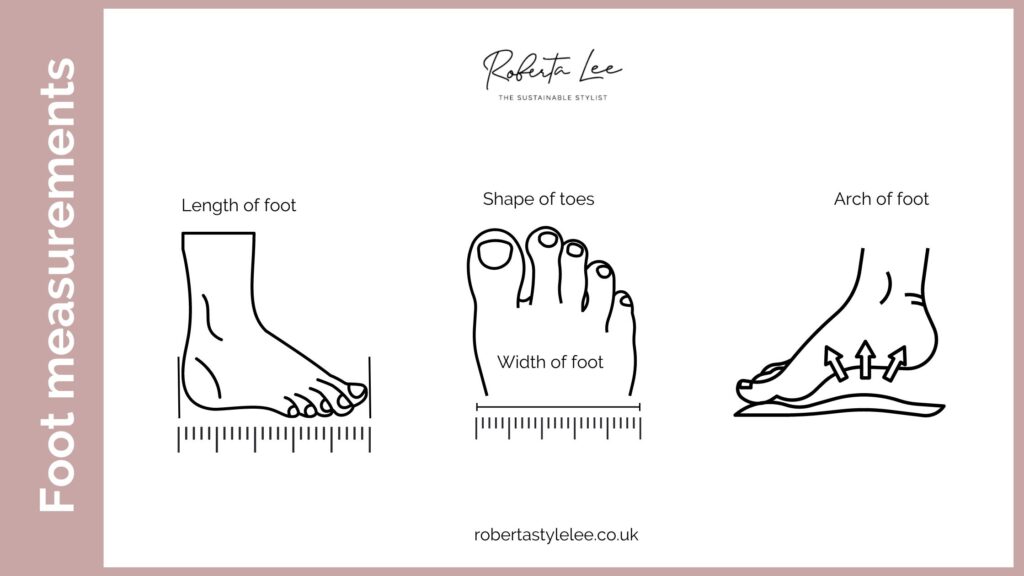Do you know the dimensions of your own feet? Most people don’t and that’s why there are millions of pairs of unworn shoes stowed in our homes around the world. There are 3-4 basic measurements and considerations you need to factor in, before buying shoes. But before dive into that, let’s look at some of the reasons why people don’t wear their shoes in the first place, and what to bear in mind before jumping into another online purchase…
What stops people wearing their shoes?

Often pretty shoes are forgotten about because comfort becomes the main priority once the shoes are purchased. Few of us can bear the discomfort of badly fitting shoes and, that is why we end up with more pairs we don’t wear. Let’s be honest, once you’ve suffered in a pair, you’re likely steer clear of said pair to avoid another blister fiasco. Buying online is very difficult because you have to rely on basic shoe sizing.
Unworn shoes are destined for landfill
I once read a stat (back in 2017) that said in the UK alone, we have so many shoes hiding in our homes that we don’t wear, that they could go heel to toe, around the world and back again. That stat back then, blew my mind.
Now with fast fashion brands churning out more plastic footwear that there are actual humans to wear them (that’s a assumed ratio btw) we’re left with mountains of shoes being donated and dumped in landfills. The problem with cheap shoes is they aren’t designed to last, nor repaired or even recycled. Finding a footwear brand that designs withe circularity in mind is pretty tough, especially is you don’t want to compromise on looking good.
Shoes are notoriously hard to recycle, I recall hosting an EBD webinar with Susannah Davda, and learning a lot about footwear and that shoes are made up of 16-parts (sometimes more, or less) and most of that is not recyclable or degradable. It’s hard to believe so many parts make up a shoe, but having worked for a fashion footwear company in North london many years ago
Measure your feet and avoid discomfort!
To avoid footwear waste and to save yourself some money and blisters, I recommend you measure your feet and ‘really’ get to know your foot dimensions. This means knowing the length and width as well as understanding the requirements for your arches and toes.
Foot measurements you should be aware of

When you buying shoes you need to be aware of your foot shape, which is determined by the length, width, shape of your toes and the arch of your foot.
You may have heard people talk about:
- A high arch
- A fallen arch
- Wide feet
- Narrow feet
- Bunions
- Wonky toes
- Non defined Achilles heel
If you’re not sure, there are a few things you can do you find out:
Foot measurement tips and instructions
- Get your feet wet and step onto a surface where you can see the ‘print’ of your foot. If you can see a full footprint, you will have low to fallen arches (this is what I have). If you can see the ball of the foot and then a narrow section which joins the heel, you will have a high arch
- Have a look at the placement of your toes and look to see if you have good symmetry. Look at the shape of your foot and determine if you have flat feet, square toes, toes on a diagonal etc. Now, look at the shape of shoes you like Vs. the shape of your feet. You’ll start to appreciate why pointed toe stilettos hurt you…
- Next, get a piece of paper and a pen and trace around each foot. Measure the width across (at the widest point) and the length from your big toe or the second toe if it’s longer (known as Morton’s toe) – This length is important to know if you’re shopping for shoes pre-loved or online.
- BONUS TIPS: get a tape measure and wrap it around your foot over your toes (where the strap of sandal would fit) this will help you avoid getting shoes where your toes slip through and don’t feel strapped in and supported at the front.
Shoes fit better the more you wear them
Another key thing to bear in mind, is these days we are too quick to give up on our shoes and we’ve forgotten about the ‘breaking in period’. When I was younger I had to break in new shoes around the house with thick socks on to help soften and mould them to my feet before I wore them outside. Why then, as adults do so many skip that part?
This works best on non-synthetic shoes, such as leather, and plant based leathers, canvas and other natural materials. PU is not designed to stretch and mould to your feet the same way.
Taking care of your shoes
To extend the life of your shoes, don’t wear them every single day. Alternate between footwear so that the moisture can evaporate which helps reduce odour and stops the materials deteriorating faster. Keep them clean regularly, even if it’s just with a damp cloth. For leather shoes, polish them before they start to crack to help them last longer. Consider repairing your shoes before they reach the point of no return. – Susannah Davda,
Shoe size guide
Now you should have a good idea about the dimensions of your own feet. Use my Shoe Size Conversion Charts blog to help you determine the best-sized shoes for you.
Please remember this is a guide, footwear brands do have their own sizes which may vary. These measurements have been taken by comparing multiple brands sizes that are available on the web – and compiled into one handy place for your convenience.
What’s your footwear story? Let me know what you discover about your own feet, and how that will change how you shop for shoes (and look after them).

PS. Let me know in the comments if you’d like me to recommend the shoes I wear for my feet, and for my clients. who often seek style and comfort. My feet are are narrow, flat with fallen arches, and I have a – and on top of that I have no defined achilles heel!




